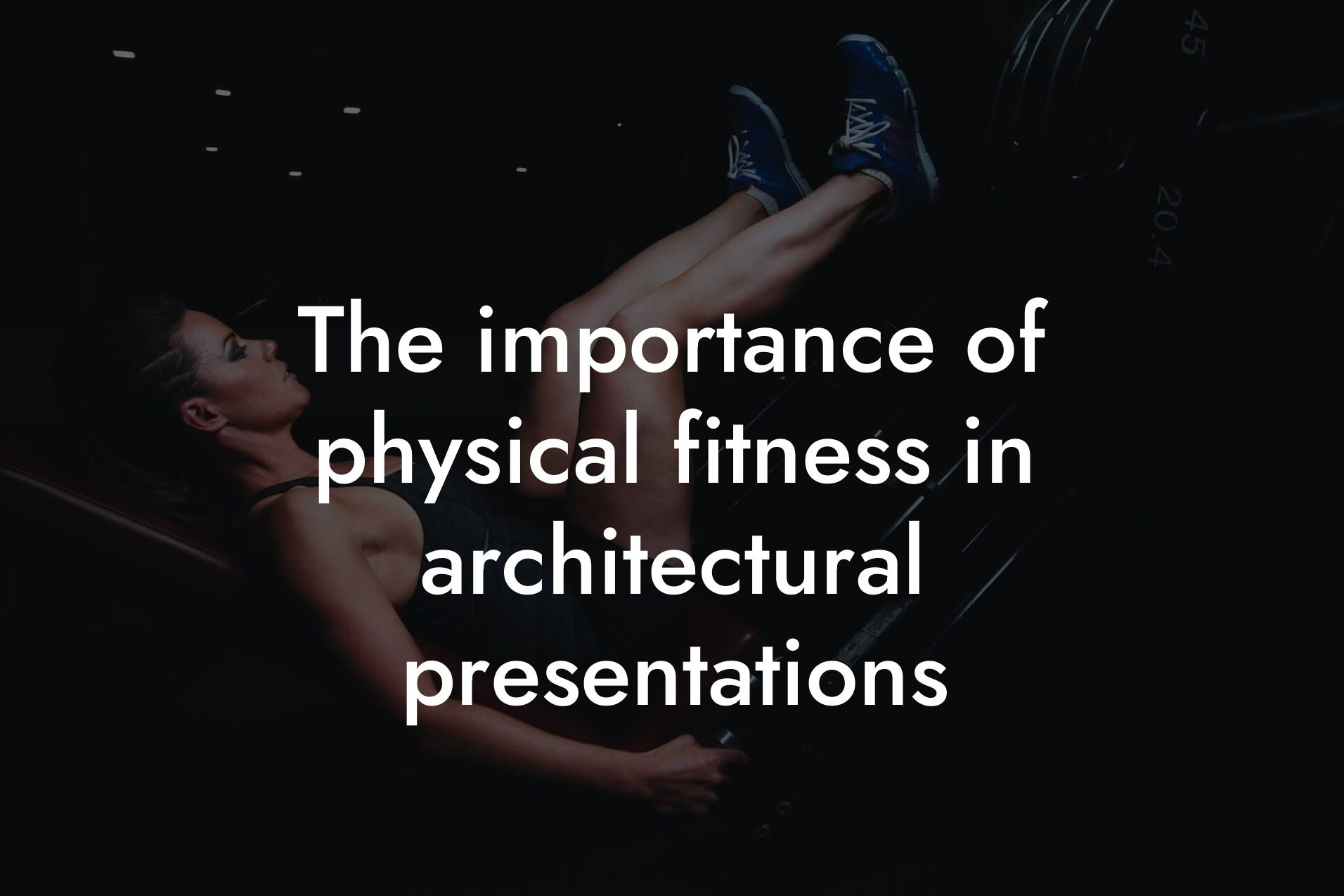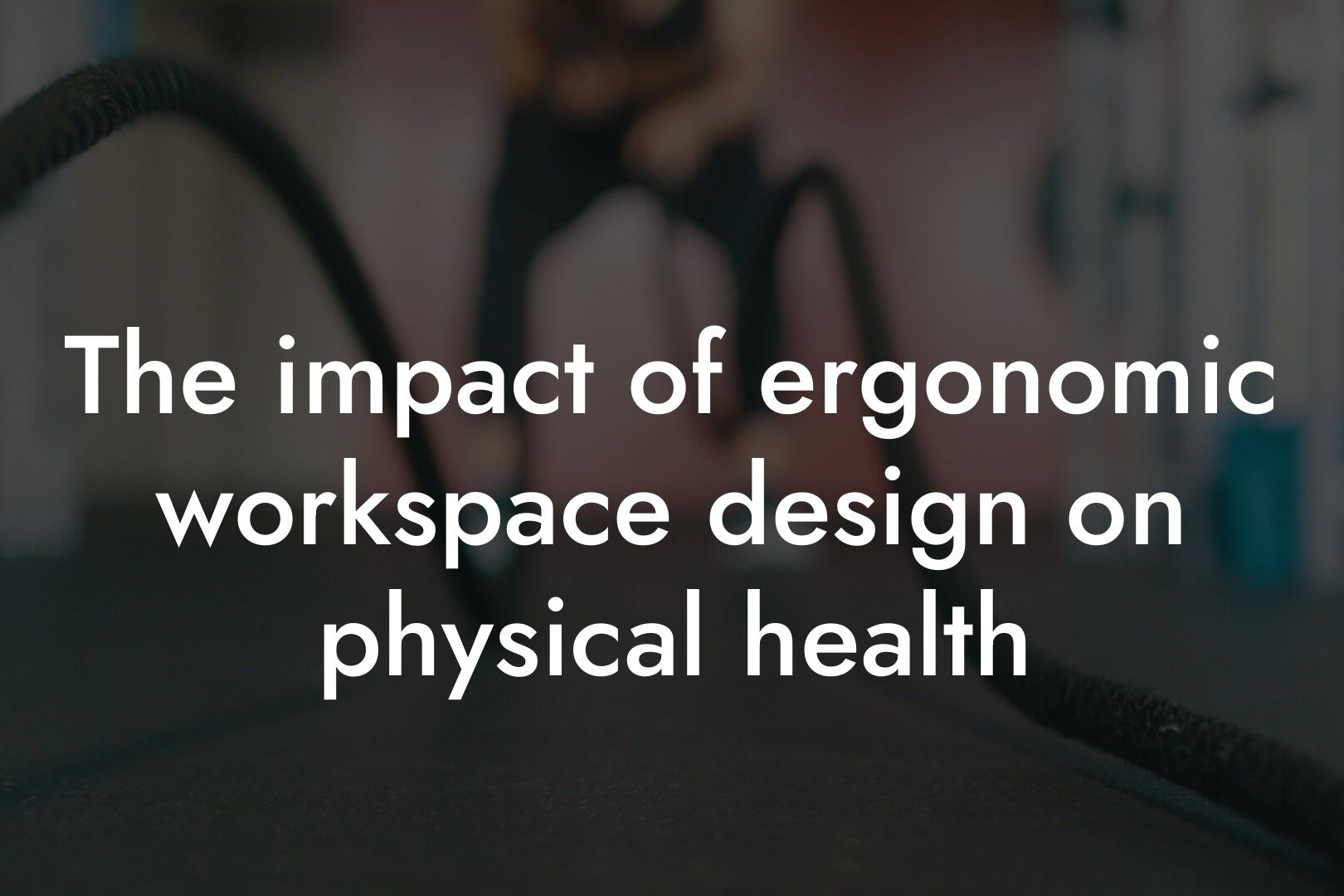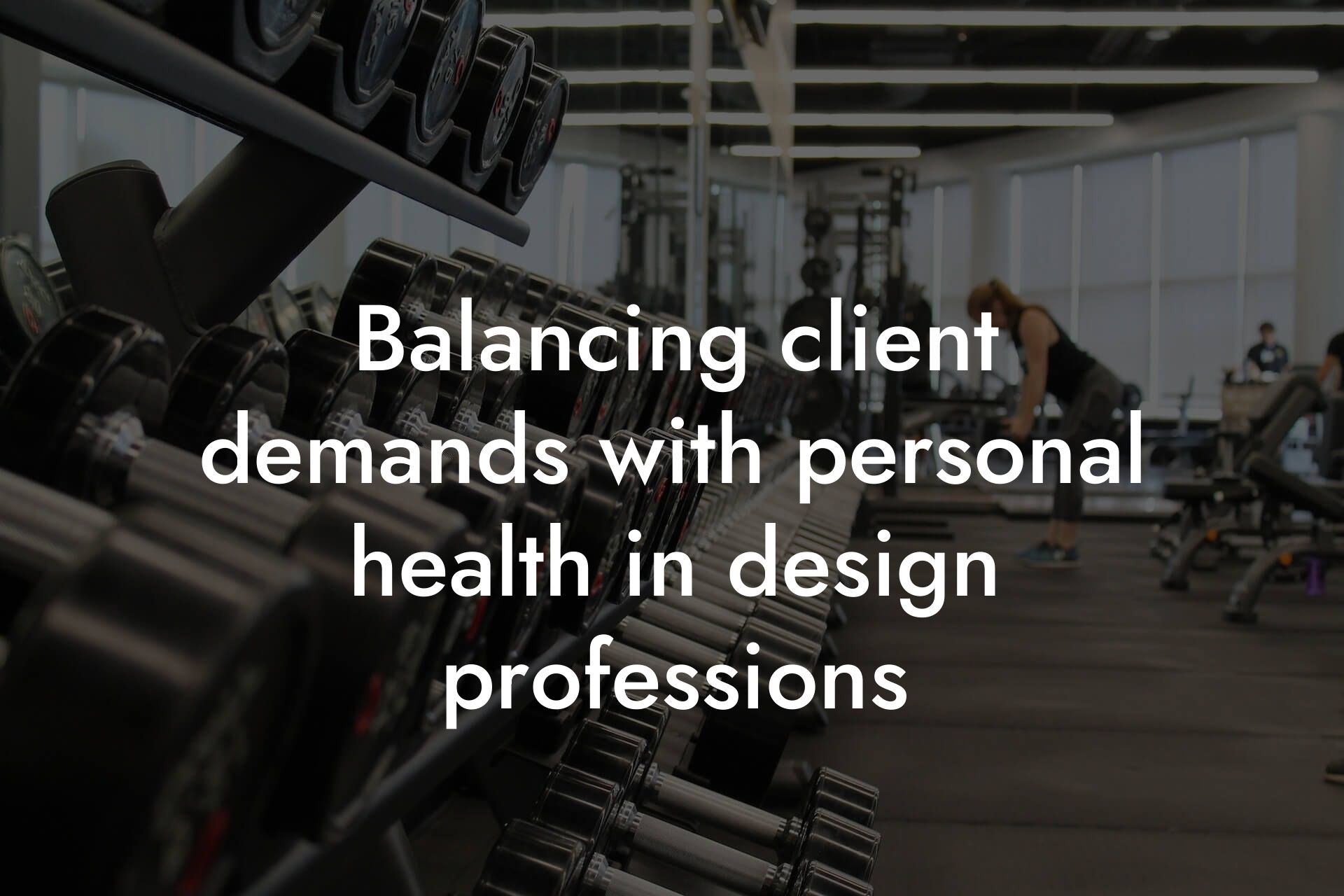As an architect, you know that long design sessions are an inevitable part of the job. Hours spent hunched over a computer, pouring over blueprints and brainstorming ideas can take a toll on your physical health. But it doesn't have to be that way. With a few simple tweaks to your daily routine and some clever strategies, you can stay fit and focused even during the most intense design sessions.
Table of Contents
- Understand the Risks of Sedentary Behavior
- Take Regular Breaks to Move Your Body
- Incorporate Ergonomic Design into Your Workspace
- Stay Hydrated and Fueled
- Incorporate Bodyweight Exercises into Your Design Session
- Use Technology to Your Advantage
- Make Time for Exercise Outside of Work
- Monitor Your Progress with DEXA Scanning
- Frequently Asked Questions
Understand the Risks of Sedentary Behavior
Before we dive into the solutions, it's essential to understand the risks associated with sedentary behavior. Prolonged sitting has been linked to a range of health problems, including obesity, diabetes, cardiovascular disease, and even certain types of cancer. As an architect, you're likely to spend a significant amount of time sitting, which can increase your risk of developing these conditions.
Take Regular Breaks to Move Your Body
One of the simplest ways to stay fit during long design sessions is to take regular breaks to move your body. This doesn't have to be anything too strenuous – even a short walk to the water cooler or a few jumping jacks can make a big difference. Aim to take a break every hour to stretch, move around, and get your blood flowing.
Try setting a timer on your computer or phone to remind you to take a break. You can also use this time to do some quick exercises, like shoulder rolls, neck stretches, or wrist extensions. These small movements can help reduce the risk of injury and improve your overall posture.
Incorporate Ergonomic Design into Your Workspace
Your workspace can either contribute to or alleviate physical discomfort. By incorporating ergonomic design principles into your workspace, you can reduce the risk of injury and stay comfortable during long design sessions. This includes:
- Using a standing desk or adjustable desk to alternate between sitting and standing
- Positioning your computer monitor directly in front of you, at a comfortable distance, and at a 90-degree angle to your line of sight
- Keeping your keyboard and mouse close to your body, with your elbows at a 90-degree angle
- Using a comfortable, supportive chair with good lumbar support
Stay Hydrated and Fueled
Staying hydrated and fueled is essential for maintaining focus and energy during long design sessions. Aim to drink at least eight glasses of water per day, and avoid sugary snacks and drinks that can lead to energy crashes.
Instead, opt for healthy snacks like nuts, fruits, and veggies, which can provide a sustained energy boost. You can also keep a stash of healthy snacks at your desk, like energy bars, trail mix, or dried fruit.
Incorporate Bodyweight Exercises into Your Design Session
You don't need to leave your desk to get a workout in. There are plenty of bodyweight exercises you can do right at your desk, like:
- Chair squats: Stand up and sit down in your chair without using your hands
- Desk push-ups: Place your hands on your desk and do push-ups
- Leg raises: Lift your legs off the floor and hold for a few seconds
- Arm circles: Hold your arms straight out to the sides and make small circles with your hands
These exercises can help improve your posture, reduce eye strain, and increase blood flow to your muscles.
Use Technology to Your Advantage
There are plenty of apps and tools available that can help you stay fit and focused during long design sessions. For example:
- Apps like Stand Up! or Move It! that remind you to take breaks and move around
- Tools like Focus@Will or Noisli that provide background noise to help you concentrate
- Software like StretchClock or Workrave that prompt you to take breaks and stretch
Make Time for Exercise Outside of Work
While it's essential to stay active during long design sessions, it's equally important to make time for exercise outside of work. Aim to do at least 30 minutes of moderate-intensity exercise per day, like brisk walking, cycling, or swimming.
You can also try incorporating strength training exercises into your routine, like weightlifting or bodyweight exercises. This can help improve your overall health and reduce your risk of injury.
Monitor Your Progress with DEXA Scanning
As an architect, you understand the importance of precision and accuracy. When it comes to tracking your physical health, you want to use the most accurate tools available. That's where DEXA scanning comes in.
DEXA scanning uses X-ray technology to measure your body composition, including your bone density, lean mass, and body fat percentage. This information can help you identify areas for improvement and track your progress over time.
At Tano Performance Group, we offer comprehensive DEXA scanning services to help high-earning professionals like you take control of their physical health. Our team of experts will work with you to create a personalized fitness plan tailored to your needs and goals.
By incorporating these strategies into your daily routine, you can stay fit and focused during even the longest design sessions. Remember to take breaks, stay hydrated, and make time for exercise outside of work. And don't forget to monitor your progress with DEXA scanning – your body will thank you!
Frequently Asked Questions
What are the common health risks associated with long design sessions?
As an architect, spending long hours at your desk can lead to a range of health risks, including obesity, back pain, eye strain, carpal tunnel syndrome, and even cardiovascular disease. Prolonged sitting has also been linked to an increased risk of diabetes, certain types of cancer, and premature mortality. It's essential to take proactive steps to mitigate these risks and prioritize your physical and mental well-being.
How can I stay focused and avoid burnout during long design sessions?
To stay focused and avoid burnout, take regular breaks every 60-90 minutes to stretch, move around, and rest your eyes. Use this time to grab a snack, chat with colleagues, or practice some quick exercises. Additionally, prioritize your tasks, set realistic deadlines, and take care of your mental health by managing stress and getting enough sleep.
What are some simple exercises I can do at my desk to stay active?
You can do a range of simple exercises at your desk, such as chair squats, desk push-ups, leg raises, arm circles, and wrist extensions. You can also try stretching exercises like neck rolls, shoulder rolls, and chest opens. These exercises can help increase blood flow, reduce muscle tension, and boost energy levels.
How can I incorporate physical activity into my daily routine as an architect?
Incorporate physical activity into your daily routine by scheduling it into your calendar, just as you would any other important task. Aim for at least 30 minutes of moderate-intensity exercise per day, such as brisk walking, cycling, or swimming. You can also try high-intensity interval training (HIIT) or bodyweight exercises during your lunch break or after work.
What are some healthy snack options I can keep at my desk?
Keep healthy snack options at your desk, such as nuts, seeds, dried fruits, energy bars, and trail mix. You can also store fresh fruits, carrot sticks with hummus, and energy-boosting drinks like green tea or coffee. Avoid sugary and processed snacks that can lead to energy crashes and decreased productivity.
How can I stay hydrated during long design sessions?
Staying hydrated is crucial during long design sessions. Keep a refillable water bottle at your desk and aim to drink at least 8-10 glasses of water per day. You can also consume hydrating foods like watermelon, cucumbers, and celery. Avoid sugary drinks and caffeine, which can lead to dehydration and decreased focus.
What are some ergonomic tips to reduce eye strain and discomfort?
To reduce eye strain and discomfort, follow these ergonomic tips: position your monitor directly in front of you, at a distance of about 20-25 inches; adjust the height of your monitor to eye level; use good lighting, avoiding harsh overhead lights; and take regular breaks to rest your eyes. You can also try the 20-20-20 rule: every 20 minutes, look away from your screen and focus on something 20 feet away for 20 seconds.
How can I prioritize my physical health as an architect?
Prioritize your physical health by making it a non-negotiable part of your daily routine. Schedule time for exercise, meal prep, and self-care. Invest in a standing desk, ergonomic chair, and other tools that promote comfort and well-being. Set health goals and track your progress, and don't be afraid to seek support from colleagues, friends, or a healthcare professional.
What are some common mistakes architects make that can negatively impact their physical health?
Common mistakes architects make that can negatively impact their physical health include neglecting to take breaks, poor posture, inadequate hydration, and consuming unhealthy snacks. Additionally, architects may prioritize deadlines over their physical well-being, leading to burnout and decreased productivity.
How can I stay motivated to prioritize my physical health as an architect?
Stay motivated to prioritize your physical health by setting realistic goals and celebrating small victories. Find an exercise buddy or accountability partner to keep you motivated. Reward yourself for reaching milestones, and don't be too hard on yourself if you encounter setbacks. Remember, every small step towards a healthier lifestyle is a step in the right direction.
What are some benefits of prioritizing physical health as an architect?
Prioritizing physical health as an architect can have numerous benefits, including increased energy levels, improved focus and productivity, enhanced creativity, and better overall well-being. You'll also be more resilient to stress, have a stronger immune system, and be less prone to chronic diseases.
How can I balance my work and personal life to prioritize my physical health?
Balancing your work and personal life is crucial to prioritizing your physical health. Set clear boundaries between your work and personal life, and schedule time for self-care and exercise. Learn to say no to non-essential tasks, and delegate tasks when possible. Make time for activities that bring you joy and help you relax, such as reading, hiking, or spending time with loved ones.
What are some resources available to architects who want to prioritize their physical health?
There are numerous resources available to architects who want to prioritize their physical health, including fitness apps, wellness websites, and health coaching services. You can also consult with a healthcare professional or a registered dietitian for personalized advice. Additionally, many architecture firms offer wellness programs, employee assistance programs, or fitness classes, so be sure to take advantage of these resources.
How can I get started with prioritizing my physical health as an architect?
Get started with prioritizing your physical health by taking small steps. Start by scheduling time for exercise or self-care, and gradually increase the duration and intensity over time. Make healthy lifestyle choices, such as preparing healthy meals or taking regular breaks. Celebrate your successes, and don't be too hard on yourself if you encounter setbacks.
What are some common myths about architects and physical health?
Common myths about architects and physical health include the idea that architects are too busy to prioritize their physical health, or that they need to sacrifice their health to meet deadlines. Another myth is that architects are naturally sedentary, and that they can't make time for exercise or self-care. However, these myths are false, and architects can prioritize their physical health with a little creativity and planning.
How can I track my progress and stay accountable to my physical health goals?
Track your progress and stay accountable to your physical health goals by using a fitness tracker, journal, or mobile app. Set specific, measurable, and achievable goals, and celebrate your successes along the way. Share your goals with a friend or accountability partner, and schedule regular check-ins to track your progress.
What are some tips for architects who work from home and want to prioritize their physical health?
As an architect who works from home, prioritize your physical health by creating a dedicated workspace that promotes comfort and well-being. Take regular breaks to move around, stretch, and rest your eyes. Schedule time for exercise or self-care, and try to separate your work and personal life. Avoid working in bed or on the couch, as this can lead to poor posture and decreased productivity.
How can I make healthy lifestyle choices when working on a tight deadline?
Make healthy lifestyle choices when working on a tight deadline by prioritizing your physical health and well-being. Take regular breaks to stretch, move around, and rest your eyes. Prepare healthy meals or snacks in advance, and avoid relying on caffeine or sugary drinks to get you through the deadline. Remember, taking care of your physical health will actually increase your productivity and focus in the long run.
What are some strategies for managing stress and anxiety as an architect?
Manage stress and anxiety as an architect by prioritizing self-care, exercise, and relaxation techniques. Take regular breaks, practice deep breathing exercises, and try to reframe your thinking to focus on the positive aspects of your work. Seek support from colleagues, friends, or a mental health professional if needed, and don't be afraid to take a step back and reassess your priorities.
How can I prioritize my physical health during peak project seasons?
Prioritize your physical health during peak project seasons by scheduling time for exercise, self-care, and relaxation. Make healthy lifestyle choices, such as preparing healthy meals or snacks in advance, and avoid relying on caffeine or sugary drinks to get you through the busy period. Remember, taking care of your physical health will actually increase your productivity and focus in the long run.
What are some tips for architects who are new to prioritizing their physical health?
As an architect who is new to prioritizing their physical health, start by making small changes to your daily routine. Schedule time for exercise or self-care, and try to incorporate healthy habits into your daily routine. Don't be too hard on yourself if you encounter setbacks, and remember that every small step towards a healthier lifestyle is a step in the right direction. Seek support from colleagues, friends, or a healthcare professional if needed, and celebrate your successes along the way.
Here are some related articles you might love...
- The importance of physical fitness in architectural presentations
- The impact of ergonomic workspace design on physical health
- Balancing client demands with personal health in design professions
- How to avoid burnout through physical activity in architecture
- How DEXA scans can benefit architects and designers
- Fitness strategies for balancing design work and physical health
- Nutrition for maintaining creativity and energy in design work
- The connection between body composition and creative output
- How to stay active during the design and build phases
Zak Faulkner
Zak Faulkner is a leading authority in the realm of physical health and body composition analysis, with over 15 years of experience helping professionals optimise their fitness and well-being. As one the experts behind Tano Performance Group, Zak has dedicated his career to providing in-depth, science-backed insights that empower clients to elevate their physical performance and overall health.
With extensive knowledge of DEXA technology, Zak specializes in delivering comprehensive body assessments that offer precise data on body fat, muscle mass, bone density, and overall physique. His expertise enables individuals to make informed decisions and achieve their fitness goals with accuracy and confidence. Zak’s approach is rooted in a deep understanding of human physiology, combined with a passion for helping clients unlock their full potential through personalised strategies.
Over the years, Zak has earned a reputation for his commitment to excellence, precision, and client-focused service. His guidance is trusted by top professionals who demand the best when it comes to their health. Whether advising on fitness programs, nutritional strategies, or long-term wellness plans, Zak Faulkner’s insights are a valuable resource for anyone serious about taking their health and fitness to the next level.
At Tano Performance Group, Zak continues to lead our Content Team revolutionising how professionals approach their physical health, offering unparalleled expertise that drives real results.




